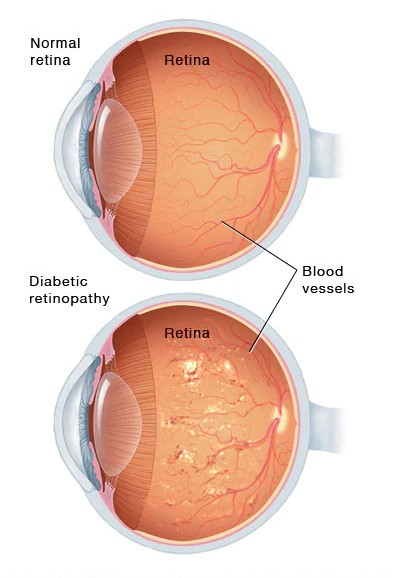DR. CNN
D
iabeticR
etinopathy usingC
onvolutionalN
euralN
etwork
Our Activity
Meet the Best Retinopathy Diagnosis
Retinopathy is most focused in helping you discover your vison.
Overcame the hurdle and problem caused by Diabetes.
Upload Image
Select image and upload it.
Run Diagnosis
Run diagnosis.
Result
Check the results
Care
Take care accordingly.
About
 Diabetic Retinopathy turns out to be a major cause of blindness in the world, Diabetic Retinopathy (DR) is caused by Diabetes Mellitus which causes development of various retinal abrasions in the human retina. These lesions cause hindrance in vision and in severe cases, DR can lead to blindness. Diabetic Retinopathy using Convolutional Neural Network helps us to identify and discover whether the patient have Diabetic Retinopathy. Deep architectures of CNN have been instrumental in providing the finesse and high performance to trained models by learning patterns from raw images, Our suggested CNN obtains a specificity of 94% on the training dataset of 14,650 pictures and an accuracy of 69% on the 3,660 validation images.
Diabetic Retinopathy turns out to be a major cause of blindness in the world, Diabetic Retinopathy (DR) is caused by Diabetes Mellitus which causes development of various retinal abrasions in the human retina. These lesions cause hindrance in vision and in severe cases, DR can lead to blindness. Diabetic Retinopathy using Convolutional Neural Network helps us to identify and discover whether the patient have Diabetic Retinopathy. Deep architectures of CNN have been instrumental in providing the finesse and high performance to trained models by learning patterns from raw images, Our suggested CNN obtains a specificity of 94% on the training dataset of 14,650 pictures and an accuracy of 69% on the 3,660 validation images.
Diagnosis
Get started with your Diabetic Retinopathy Diagnosis
No DR : No Diabetic Retinopathy is found.
Mild DR : Initial stage, the patient must become educated on the possible ramifications of diabetes, while taking steps to better control their blood sugar and diet and decrease the risk of diabetic retinopathy progression and vision loss.
Moderate DR : Leakage of blood and fluid into the retina tissue. This fluid can cause a loss of vision. Referral to a specialist for further evaluation and possible treatment may be appropriate and recommended.
Severe DR : A timely referral to an eye specialist is nearly always appropriate. The good news is that often, some, if not all, of the lost vision can be improved with appropriate treatment.
Proliferative DR : Final stage, the disease has advanced significantly and is very threatening to one's vision.Patients require immediate referral to a retina specialist for further examination and treatment.
Model Information
Diabetic Retinopathy (DR) is caused as a result of Diabetes Mellitus which causes development of various retinal abrasions in the human retina. These lesions cause hindrance in vision and in severe cases, DR can lead to blindness. DR is observed amongst 80% of patients who have been diagnosed from prolonged diabetes for a period of 10-15 years.
Our suggested CNN obtains a specificity of 94% on the training dataset of 14,650 pictures and an accuracy of 69% on the 3,660 validation images.
Because there is not enough data, it is enhanced to make the dataset larger. The data is split into two sets: the training set has 2,930 photos, while the validation set contains 732 images.
The original pre-processed photos are insufficient to sufficiently train the model. All of the photographs are enhanced using techniques including rotation, magnification, horizontal flip, vertical flip, blurring, brightness, and saturation in order to maximise the number of images. Using the ImageDataGenerator in the Keras Preprocessing Library, all parameter values were created at random and then applied.The final dataset includes 3,660 pictures for the validation dataset and 14,650 images for the training dataset.
A confusion matrix is a table that is used to define the performance of a classification algorithm. A confusion matrix visualizes and summarizes the performance of a classification algorithm.
